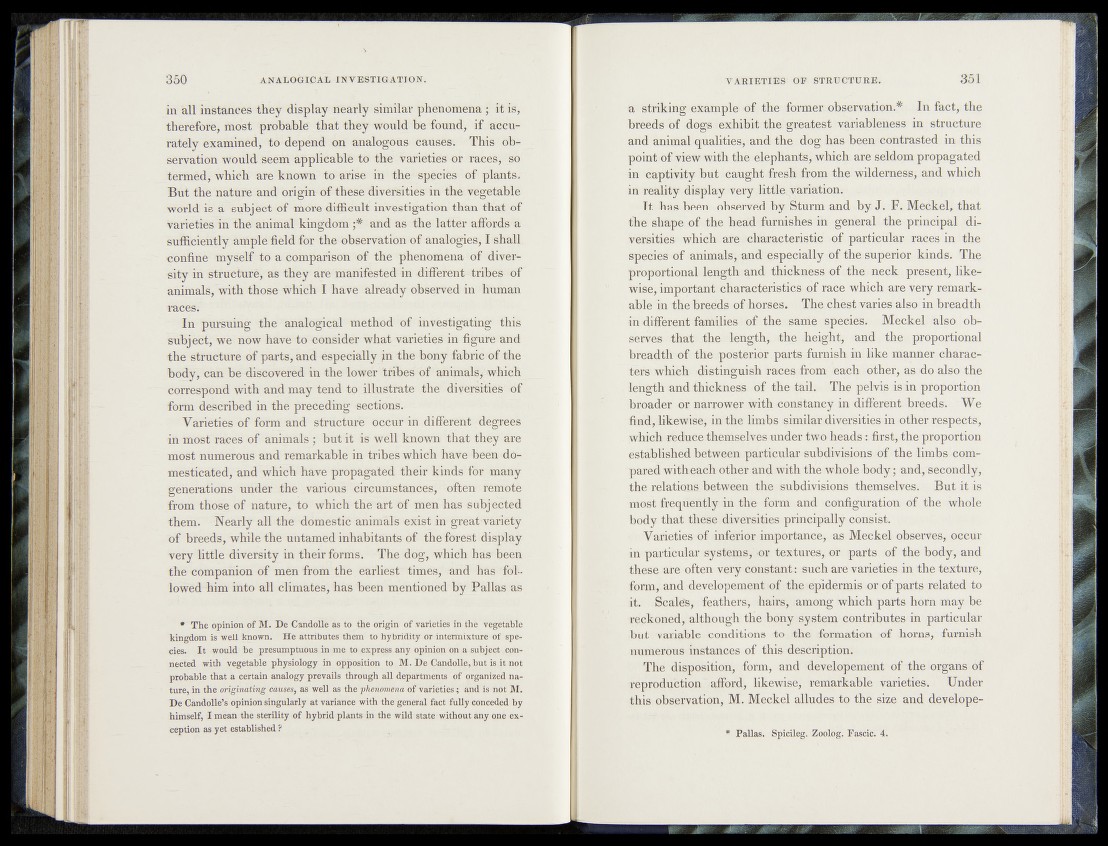
in all instances they display nearly similar phenomena; it is,
therefore, most probable' that they would be found, if accurately
examined, to depend on analogous causes. This observation
would seem applicable to the Varieties or races, so
termed, which are known to arise in the species of plants.
But the nature and origin of these diversities in the vegetable
world is a subject of more difficult investigation than that of
varieties in the animal kingdom and as the latter affords a
sufficiently ample field for the observation of analogies, I shall
confine myself to a comparison of the phenomena of diversity
in structure, as they arë manifested in different tribes of
animals, with those which I have already observed in human
races.
In pursuing the analogical method of investigating this
subject, we now have to consider what varieties in figure ~and
the structure of parts, and especially jin the bony fabric of the
body, can be discovered in the lower tribes of animals,-Which
correspond with and may tend to illustrate the diversities of
form described in thé preceding sections.
Varieties of form and structure occur in different -degrees
in most races of animals; but it is well known that they are
most numerous and remarkable in tribes which have been domesticated,
and which have propagated their kinds fdr many
generations under the various circumstances, • often remote
from those of nature, to which the art Of men has subjected
them. Nearly all the domestic animals exist in great-variety
of breeds, while the untamed inhabitants of the fbrest display
very little-diversity in their forms. -The dog, which has’been
the companion of men from the earliest times, and has'folk
lowed him into all climates, has been mentioned by Pallas as
* The opinion of M. De CandoÜe as to the origin of varieties in the vegetable
kingdom is well known. He attributes them to hybridity or intermixture of species.
I t would be presumptuous in me to express any opinion on a subject connected
with vegetable physiology in opposition to M. De Candolle,but is it not
probable that a certain analogy prevails through all departments of organized nature,
in the originating causes, as well as the phenomena ox varieties ; and is hot M.
De Candolle’s opinion singularly at variance with the general fact fully conceded by
himself, I mean the sterility of hybrid plants in the wild state without any one exception
as yet established ?
a striking example of the former observation.* In fact, the
breeds of dogs exhibit the greatest variableness in structure
and animal qualities, and the dog has been contrasted in this
point of view with the elephants, which are seldom propagated
in captivity but * caught fresh from the wilderness, and which
in reality display very little, variation.
It has-been observed ,by Sturm and by J. F. Meckel, that
the shape of the head furnishes in general the principal diversities
which are characteristic of particular races in the
speiliss: o f animals, and especially of the superior kinds. The
proportional length and thickness of the neck present, likewise,
important characteristics of race wh|qn are very remarkable
in the breeds of-horses. The chest varies also in breadth
in different familiesi.iof the same species. Meckel alsp lob-
senves th a t the length, the height,, and the proportional
breadth of the posterior , parts furnish, in lake manner eh^fac^
ters which distinguish races -from bach other,,as. do also the
length -and thickness bf the tail. The pelvis is in proportion
broader or narrower with constancy in different breeds. We
find, likewise^ in the limbs similar diversities- in other respects,
which rediuee themselves under two heads: first, the proportion
established between particular subdivisions $£.-the limbs compared
with each other and.with the whole body; and,.secondly,
the relations, between the subdivisions themselves. ■ But ft i§
most frequently in the- form and ^configuration, of the whole
body that these diveTsities principally consist.
Varieties of inferior importance, as Meckel, (observes,, occur
in particular systems.,>©r textures, or parts of the body, and
these are often very constant: such are varieties in the texture,
form, and developement »©frthe epidermis or-of parts related to
it. Scalds, feathers, hairs, among which parts horn may be
reckoned, although the bony system contributes in particular
but variable conditions »to ithe formation df horns, furnish
numerous instances of this description.
The disposition, form, and developementr of the organs of
^reproduction" afford, likewise, remarkable varieties* • Under
this observation, M. Meckel alludes to.ithe size and develope-
* Pallas. Spicileg. Zoolog. Fascic. 4.